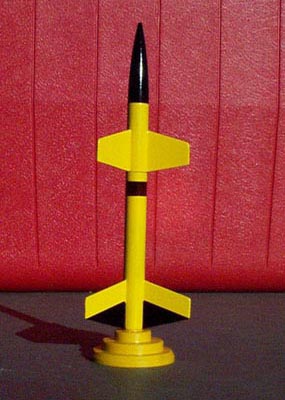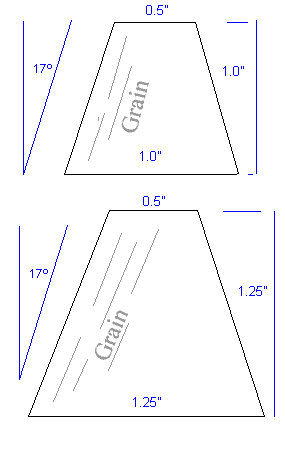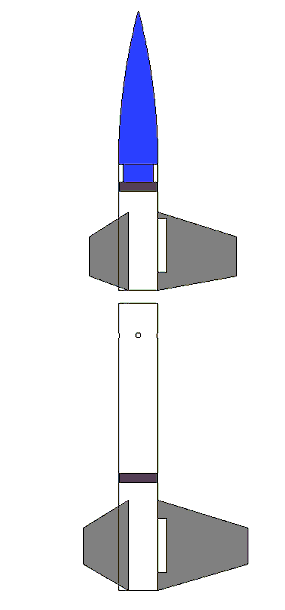Descon 5 MicroBee Original Design / Scratch Built
Scratch - MicroBee {Scratch}
Contributed by Robert Geer
| Manufacturer: | Scratch |
 My desire for a 2 stage rocket finally got the better of me, I had an extra Estes BNC-5 nose, some BT-5 tubing and some 1/16" Basswood left over after building a replacement glider for my ARV Condor (the old one flew VERY well!).
My desire for a 2 stage rocket finally got the better of me, I had an extra Estes BNC-5 nose, some BT-5 tubing and some 1/16" Basswood left over after building a replacement glider for my ARV Condor (the old one flew VERY well!).
Anyway, I decided that this rocket would not eject the motors, I've seen the Quark and some other lawn darts and they NEVER tumble coming back down. I wanted to try something different that I'd read about in the Handbook of Model Rocketry. So this is a "Nose Blow" recovery rocket (more on recovery in the flight report), I recently purchased RockSim from Apogee so I started with those pieces.
After about an hour and a half playing with RockSim I had my plans and and a pretty good idea how it would fly. It stands a majestic 7 7/8" tall and weighs in a shade under 1 oz fully loaded. It simmed out to over 1500 feet. But I can't verify that. (see the flight report below)
Upper Stage:
The upper stage consists of the nose cone, a 1 3/4" piece of BT-5, an 8 1/2" piece of 70lb test Kevlar, a 0.2oz fishing weight, a very small eye hook, three basswood fins and a 1/8" piece of a spent Estes A3-4T motor casing for the motor block.
The first thing I had to do was trim the shoulder of the nose to 3/16" to make room for the motor block, after that I put some epoxy on the threads of the eye hook and screwed it into the hole in the fishing weight. I tied the Kevlarto the eye hook and covered other end and the sides of the weight with epoxy and stuck as far inside the nose as I could.
 While that was drying, I cut notches in the top, bottom and outside of the motor block just large enough so the Kevlar would lay inside the groove then I wicked some thin CA into the ends of the body tube and motor block. After the CA was set I attached the Fins with carpenters glue, the trailing edge of the fins are even with the end of the tube.
While that was drying, I cut notches in the top, bottom and outside of the motor block just large enough so the Kevlar would lay inside the groove then I wicked some thin CA into the ends of the body tube and motor block. After the CA was set I attached the Fins with carpenters glue, the trailing edge of the fins are even with the end of the tube.
Once the fins were dry, I tied the Kevlarto the motor block and smeared some carpenters glue in the Body tube about 1/2" from the nose end and pushed the motor block into the body tube with the shoulder of the nose making sure that the knot in the Kevlarwas not interfering with the nose or the motor fit.
Make sure that the motor hangs out the aft end of the airframe at least 3/8". This allows the motor to act as a coupler for the sustainer and booster.
I attached a 3/4" piece of Estes launch lug at the fin/body joint near the leading edge of the fin with carpenters glue. The paint scheme is sunflower yellow for the body and gloss black on the nose .
Booster Stage:
The Booster is made from a 4" piece of BT-5, another 1/8" piece of a spent Estes A3-4T motor casing and three 1/16" basswood fins. Again I wicked some thin CA into the ends of the body tube and motor block.
After it set, I drilled 4 1/8" holes 7/16" from one end of the tube spaced 90º apart. I added thin CA to the edges of the holes for strength. The number and size of the holes was an educated guess.
 I installed the motor block by smearing carpenters glue inside the other end of the tube about 3/4" from the end and slid the block in with a motor marked 1/2" inch up from the end. I removed the motor and checked that there was a good fillet of glue on top of the motor block and let the glue dry with the tube standing upright.
I installed the motor block by smearing carpenters glue inside the other end of the tube about 3/4" from the end and slid the block in with a motor marked 1/2" inch up from the end. I removed the motor and checked that there was a good fillet of glue on top of the motor block and let the glue dry with the tube standing upright.
I attached the fins and launch lug to the booster the same as the upper stage. I got a little bolder with the paint on the booster, the band at the top is to hide the vent holes and the triangles on the fins is just because I thought it needed something.
Flight Report:
Saturday Sept. 11, 1999 10:45 am. The first launch was just the sustainer portion loaded with an Estes 1/2A3-4T taped for a very snug fit, I coiled the Kevlar inside the nose and put it on the pad. It leaped off the pad and shot up about 500 ft, ejection occurred a little before apogee, but I expected that from the data I got from RockSim. It tumbled down exactly as I had hoped with the nose and body spiraling and landed in the grass about 8 ft from the pad. I inspected for damage and found none.
11.02 am So now the big test, I loaded another Estes 1/2A3-4T into the sustainer, and an Estes A10-0 in the booster. It was only a little slower of the pad this time flying nice and straight, the booster burned out, the second stage lit kicking the booster off. There were five of us watching, we all saw the delay smoke from the upper stage (waaay up there!) but that was the last trace of the upper stage. I guess apogee was somewhere upwards of 1200 ft.
I have one more BNC-5 nose cone, I guess it's time to build another one!
The MicroBee.rkt RockSim file is available
by right clicking here and selecting save.
Sponsored Ads
 |
 |











